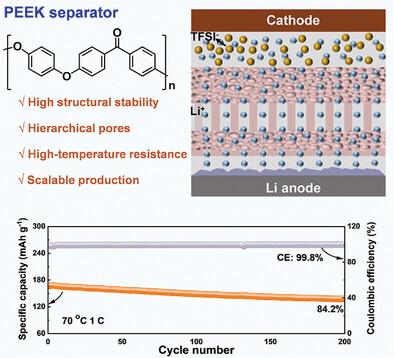Advanced Poly (Ether Ether Ketone) Separator for Lithium Metal Battery
IF 13
2区 材料科学
Q1 CHEMISTRY, MULTIDISCIPLINARY
引用次数: 0
Abstract
The development of high-performance separators is urgently needed to improve the safety and electrochemical performance of high-energy-density lithium metal batteries (LMB). Poly (ether ether ketone) (PEEK) is an ideal separator candidate due to its high chemical resistance and excellent thermal stability. However, the processing of PEEK for separators with proper porous structure is rather challenging. Beyond the conventional sulfonation process of PEEK, here, a reversible chemical modification strategy is exploited to fabricate heat-resistant PEEK separators with sophisticated hierarchical pore architecture. The lyophilic PEEK separators including dense surface layers, middle layers with horizontally aligned pore arrays, and honeycomb-structured bottom layers enable fast ion transport and uniform Li+ flux, realizing dendrite-free characteristics during the lithium deposition process. Hence, the PEEK separator assembled LiFePO4||Li battery delivers a remarkable capacity of 103.6 mAh·g−1 after 1000 cycles at 3 C, and offers more than two times longer cycle life than that of other PEEK-based separators. Even at 70 °C, a high capacity retention rate of 84.2% is achieved after 200 cycles, ensuring battery safety in high-temperature environments. Different from the commonly used surface modification strategy for functional separators, the approach reported herein exhibits a fundamental advance in separator manufacturing for future high-safety LMBs.

求助全文
约1分钟内获得全文
求助全文
来源期刊

Small
工程技术-材料科学:综合
CiteScore
17.70
自引率
3.80%
发文量
1830
审稿时长
2.1 months
期刊介绍:
Small serves as an exceptional platform for both experimental and theoretical studies in fundamental and applied interdisciplinary research at the nano- and microscale. The journal offers a compelling mix of peer-reviewed Research Articles, Reviews, Perspectives, and Comments.
With a remarkable 2022 Journal Impact Factor of 13.3 (Journal Citation Reports from Clarivate Analytics, 2023), Small remains among the top multidisciplinary journals, covering a wide range of topics at the interface of materials science, chemistry, physics, engineering, medicine, and biology.
Small's readership includes biochemists, biologists, biomedical scientists, chemists, engineers, information technologists, materials scientists, physicists, and theoreticians alike.
 求助内容:
求助内容: 应助结果提醒方式:
应助结果提醒方式:


